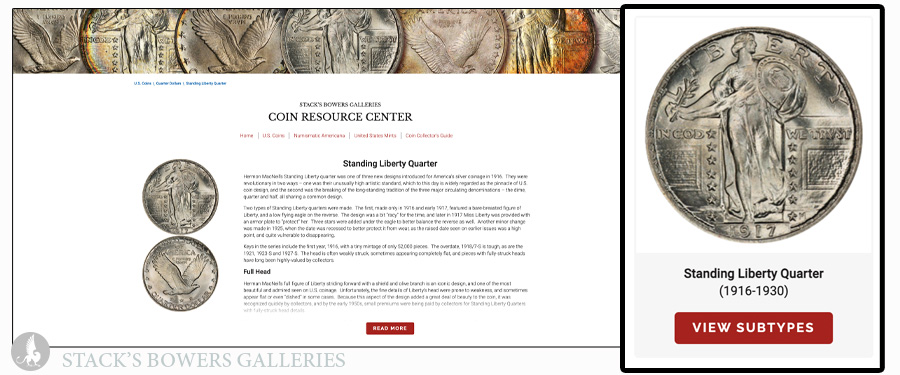
Designed by Hermon Atkins MacNeil, a Massachusetts-born, French-trained sculptor perhaps best-known outside of the numismatic world for his many public monuments and sculptures depicting Native Americans, the Standing Liberty quarter was introduced in 1916. Part of a redesign/beautification program of the United States’ coinage referred to by numismatic historians as the Renaissance of American Coinage, the Standing Liberty quarter’s life proved relatively short, concluding in 1930.
Stack’s Bowers Galleries Coin Resource Center, an online database of information relating to collectible U.S. and North American Colonial coins launched earlier this year, includes entries on every date in this series of quarters. The obverse of a 1927-S Standing Liberty quarter – one of the series’ keys – is the thumbnail of the overall quarter denomination on the CRC.
Under the terms of an 1890 law that allowed coin designs to be changed by the Treasury without Congressional approval, Mint Director Robert Woolley solicited designs from three notable artists outside of the Mint. MacNeil’s Standing Liberty obverse motif, likely a composite portrait of actresses Doris Doscher and Irene MacDowell, holds a shield striking something of a defensive pose, with an olive branch in her right hand. These images are thought to evoke the United States’ ability and willingness to defend itself, influenced no doubt by the ongoing First World War.
Attractive as the design was, it proved difficult to strike, with softness around the most detailed devices, a characteristic common to many examples. To improve strike quality and stackability and to better convey the defensive theme, chain mail was added covering Liberty’s breast, which was exposed on the 1916 and early 1917 issues. Other changes included the addition of three stars under the eagle on the reverse. These modifications separate the series into its two major subtypes.
Consistently weak strikes place a premium on sharply struck examples with intact details. The fullness of Liberty’s head on the obverse is the most important metric used by collectors to determine strike quality. Coins displaying a “Full Head” (abbreviated as FH on third-party grading service holders) command a premium over their flatter counterparts and have since at least the early 1950s, per the CRC listing. Descriptions of the requirements and Full Head Images of heads with varying degrees of fullness appear.
The date was insufficiently recessed on early date examples, causing it to wear off quickly in circulation and the date was recessed beginning in 1925.
Stack’s Bowers Galleries’ Coin Resource Center section on the Standing Liberty quarter series includes an overview with links to separate pages the two major subtypes: Type 1 and Type 2. Each of these pages includes links to each date, where a discussion of rarity and collectability will be found, along with links to recent auction appearances and Coin in Motion animations, as available. The Coin Resource Center includes all dates in the Standing Liberty quarter series.





